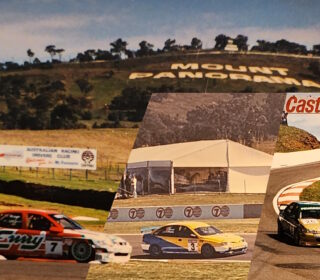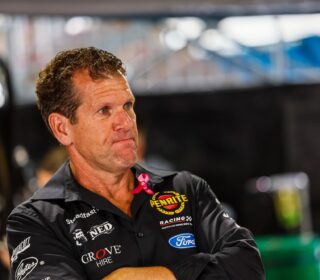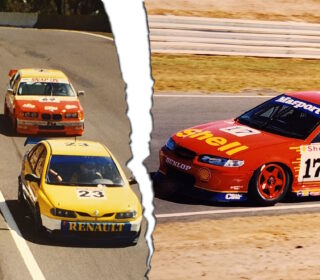Nationals: the story of the stable second tier series that could
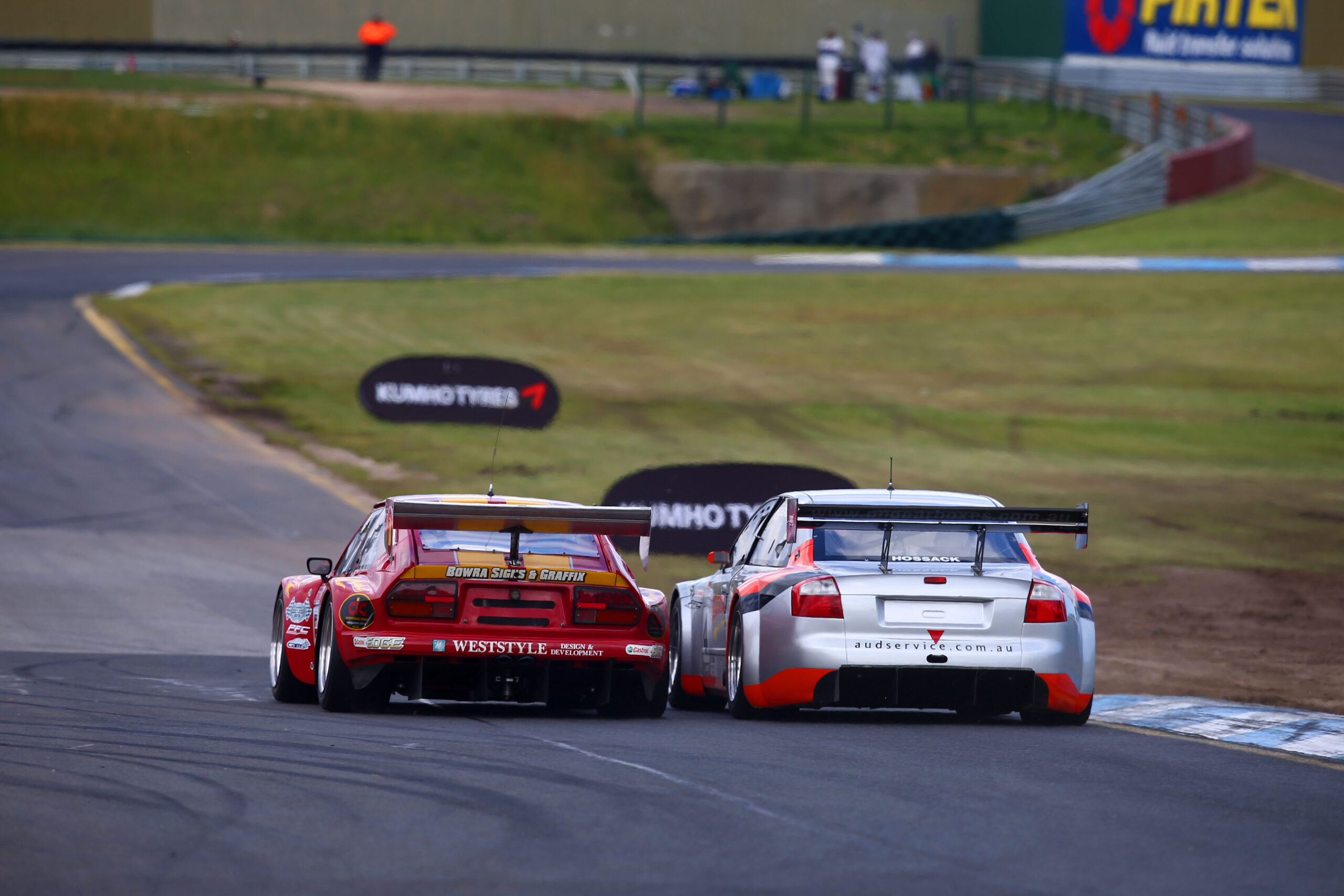
AS THE rain lashed The Bend Motorsport Park on a wet, ultimately depressing Sunday afternoon in late October, an unheralded Australian Motorsport success story slipped quietly into the history books.
As the transporters headed off into the sodden afternoon and the circuit fell quiet, the tenure of Australia’s longest lived second-tier national motor racing series came to a quiet and all too anticlimactic close.
Sunday marked the final round of the Shannons Motorsport Australia Championships, which in 2022 will be replaced by the new ‘unified’ SpeedSeries, run jointly by both Motorsport Australia and the Australian Racing Group.
It places a full stop on the tenure of a series that began in 2006, at a time of challenge for the industry that lived outside the Supercars bubble.
For much of its life, the ‘Shannons’ series operated without much in the way of grandeur, pomp or circumstance; instead, it operated more as a necessity – a series that existed for the product as much as, if not more than, the show.
But from it’s early genesis as the CAMS National Motor Racing Championships to the Shannons Nationals and its final stanza as the unfortunately-tagged ‘SMAC’ – that never caught on, for obvious reasons – the ‘Shannons’ tour played an incredibly significant role in stabilising the sport and, ultimately, building it bigger and better than ever.
However, to chart the history of the Shannons tour you have to go back, well back, beyond its formation in 2006 to tell the tale of ‘second tier’ national level motorsport in Australia, and it’s long and bumpy road to today.
FOR MUCH of the last thirty years the Australian Touring Car Championship / V8 Supercars / Supercars Championship program has been the main game in the sport.
It’s events are the biggest, the best-attended, the most covered by media and the most financially viable.
For categories outside of the Touring Cars themselves, it’s the premier slot to race on.
But there’s always been a secondary tier to the sport – racing at a national level, either fully professionally or at a semi-pro level and as either an alternative or in competition to the big dogs in V8 land.
Racing program’s like the ARDC’s AMSCAR series at Amaroo Park in the 80s and early 90s were more of a companion piece to the big show. Super Touring was certainly pitched as an alternative and famously led to the two litre versus V8 war of the late 1990s.
And then there was PROCAR, a racing entity formed by a motorsport business mogul from a disparate group of categories into something that was, at its peak, rather excellent.
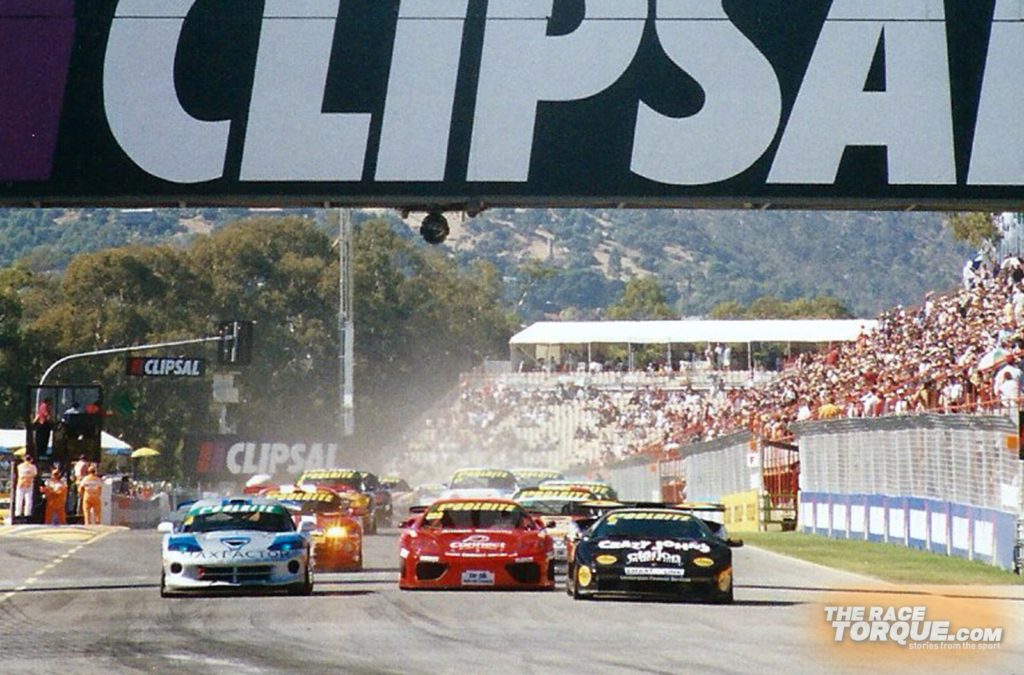
PROCAR was created by long-time motorsport fan and sponsor Ross Palmer as the overarching body behind a group of key racing categories he owned and ran.
After forming through the creation of the GT Production Category in the 1990s, it evolved to become Australia’s key second-tier racing tour behind the V8 Supercars.
Headlined by the Nations Cup GT Championship and the incredibly popular V8 BRUtes, and ably supported by GT Performance, Production and Formula 3, the PROCAR Tour was healthy, well-promoted, well covered and well attended. If not an out and out rival for Supercars, it was a strong alternative and for a time it flourished.
However, it’s move to run as a stand-alone series, in addition to the incredible investment required to stage the Bathurst 24 Hour in 2002 and 2003, added financial strain to Palmer’s admittedly deep pockets.
In one of the more shocking announcements in the sport’s long history, in early 2004 Palmer announced that PROCAR wad dead; to be shut down immediately.
It was a hammer blow to the sport and the categories involved, all of whom scrabbling to secure a way out of the mess in both the short and long term.
The short-term saviour came in the form of long-time racer Peter Boylan, who along with the categories and willing circuits bankrolled the remainder of the 2004 PROCAR tour, at least giving some breathing room to the competitors and categories involved.
PROCAR Mark two, however, never looked like it was going to be anything more than a short-term thing.
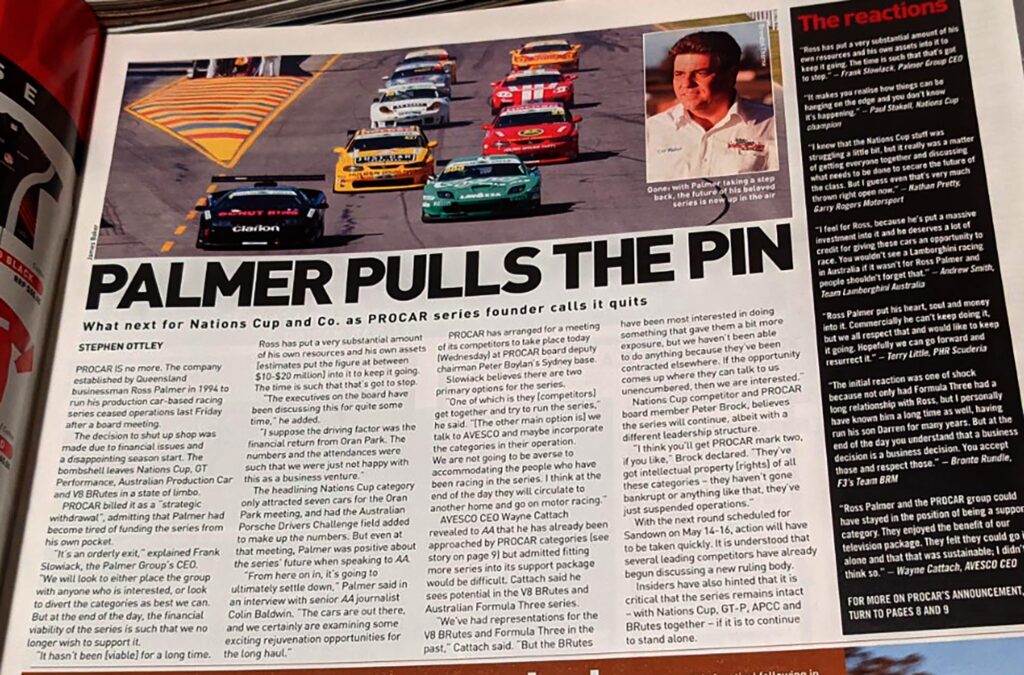
AT THE end of the 2004 season the various categories split apart from under the PROCAR banner.
The popular V8 Utes stood on their own, under the expert management of Craig Denyer and Bill West, and were quickly snapped up by the Supercars Championship as a premier support category where they would remain.
GT Performance did much the same under their own management, though to less long-term success, while the Australian Production Car Association took over the management of production car racing below the GTP level.
Nations Cup, sadly, died. The bastion of the incredible GRM Monaro’s was always an outlier in global GT racing, never fitting to an established set of regulations and rife with politicking and parity. It was clear a new start was needed, which came in the form of the entrepreneurial Terry Little and his foundation of the Australian GT Championship in early 2005.
Formula 3 were already a stand-alone category and so just needed a place to race.
WITH the backing of CAMS, in 2005 the ‘Australian Motor Racing Series’ was founded by racers Garry Wilmington and Rod Dale.
A much more grassroots-based operation than the expansive, expensive PROCAR, the AMRS offered a lifeline for several of the categories displaced by the demise of the existing promoter.
Under the ‘Speed, Power, Action’ banner, the AMRS gathered 10 categories from various levels of motor racing abandonment. The newly-formed Australian GT Championship merged with the Porsche Drivers’ Challenge and joined the grid. PROCAR refugees Formula 3 and Australian Production Cars did the same, while the now Gold Star-less Formula 4000 migrated off the Supercars program.
The National Sports Sedan championship and Commodore Cup national tour joined the fun, as did the then-new Saloon Car Series, billed as the replacement for HQs.
Finally, the ‘Touring Car Challenge’, a diverse mix of ex-Supercars, Super Touring, Future Tourers and others, was the last tenuous link to the TOCA Super Touring program that has petered out by the early 2000s.
On paper and at times in reality, the AMRS was a pretty compelling mix. Certainly at a much lower level than what had existed before, but serviceable none the less.
However, it wasn’t to last. Almost as the AMRS season began so too did discussions for a revised model, led by CAMS and their core categories, and doing their own thing.
WORK began apace in 2005 to create from scratch another second-tier championship, one that would operate on a more inclusive business model than had been seen previously.
With CAMS as a major shareholder, key categories – Formula 3, GT / Porsche Drivers’ Challenge, Australian Production Cars, Saloon Cars and Commodore Cup – and circuits including Eastern Creek, Phillip Island, Queensland Raceway and Mallala were to work together to promote a national second tier tour.
Aside from a solid TV package, there would be few frills; this series would be designed to be economical first, stable second and everything else next.
Experienced motorsport administrator Rob Curkpatrick was hired by the new entity to manage the series.
The five initial ‘core’ categories invested in the Nationals were Formula 3, Sports Sedans, Production Cars, Commodore Cup and Saloon Cars.
Additional categories including Australian GT, Superkarts, Performance Cars (once known as GTP) and even the V8 Utes formed part of the program.
2016 marked the final year that any ‘founding categories’ remained on the Nationals program, with Formula 3 and Sports Sedans ending their run on the schedule last year.
Shannons first sponsored the series in 2007 and has continued to back the series to this day.
Their unbroken support has seen the brand become eponymous with the series itself.
Shannons Nationals promoters have backed the introduction of several key categories that remain a staple on the motor sport landscape.
V8 Touring Cars struggled in its initial two seasons, running races with as few as four entries – in fact an early round at Symmons Plains only had three confirmed runners before a last-minute deal was done to secure a fourth.
Still, the series kept the faith in the category and it ultimately flourished to the point where it is now a regular on the Supercars program, as Super3.
The same can be said for when a group of Porsche enthusiasts came to the series and asked for a place to run their new series.
The Porsche GT3 Cup Challenge was founded with 13 cars on a blustery Mallala day in early 2008 and has since become one of the premium categories on the schedule – and a key part in Porsche’s significant commitment to local motorsport.
The first ‘big’ moment of the Shannons Nationals was a crash.
Dean Randle’s remarkable flip in his Chevrolet-powered SAAB at Phillip Island in May 2006 was the first instance of the Nationals gaining exposure outside of the national-level motorsport scene.
The incredible aerobatics, from which Dean emerged unscathed, have been replayed countless times and have even made ‘classic crash’ videos around the world.
Though we’re still not sure if it’s from the crash itself, or Dean’s helmet-chucking afterwards..
The next big moment was a win.
Australian Formula 3 hit its straps in the 2007 season with an intensely competitive field fighting it out for the Gold Star, but it was Leanne Tander’s presence who dominated the headlines.
Even 15 years ago, women in motorsport didn’t carry the same public awareness as it does today so Leanne’s performances grabbed plenty of attention – and when she stormed to her first victory at Phillip Island in May that year it generated mainstream press coverage for F3 and the Nationals.
Leanne would ultimately contend for the championship that year (and the next), only for Tim Macrow to edge her by two points in a thrilling finale’ at Oran Park.
There was also some cracking battles over the journey.
However, few of them stand out like the longstanding rivalry between Sports Sedan competitors Darren Hossack and Tony Ricciardello.
Any time the pair, one in the stunning bright-red Alfetta GTV and the other in a sinister Audi-Chev, got near each other on track you simply had to sit and watch.
It was the ultimate example of the two fastest drivers on the grid driving the two fastest cars on the grid as hard as they could possibly be driven – and it resulted in some breathtaking racing.
As a testament to their consistent and consistently brilliant performances over the period, both made it into the top five drivers in a top-10 list of all-time great Nationals drivers, presented at the end of the Nationals’ 10th season in 2015.
One of the best things about the Shannons Nationals was an ability to innovate.
The series always had the flexibility and the backing of the competitors to do something different that can help promote the sport to a new audience.
It started with a regular, two-hour TV package on Speedweek and evolved into the introduction of live streaming in 2010 – some time before regular streaming of local motorsport became a thing.
Then there was the introduction of night racing at Queensland Raceway – which continues to this day via the annual ‘Fight in the Night’. Races remembering or commemorating loved figures from within each series were also a highlight: including Commodore Cup’s Ashley Cooper Memorial and the Clem Smith Cup and Des Wall Trophy in Sports Sedans.
‘Marquee’ events had also been introduced at Nationals rounds – including the above-mentioned night-race for Production Cars in Queensland, the Porsche Carrera Cup ProAm and GT3 Cup Challenge Jim Richards enduro trophy races, or the Australian GT Phillip Island 101.
Thinking outside the box and bringing national-level racing to places like Morgan Park, for example, were also a highlight.
There were challenges along the road.
Whether it was categories like Commodore Cup or the Suzuki Swift series folding or circuits – like Oran Park – closing, the road wasn’t always been smooth.
And then there was Sydney Motorsport Park 2014, when the series was plunged into a firestorm of publicity, literally, when teenager Brock Giblin had an enormous crash and was badly burned during practice.
However through it all the concept preserved and survived as the stable second-tier platform that the sport needed.
NEXT UP: We remember the 99(ish) best moments from the history of the Shannons Nationals.



